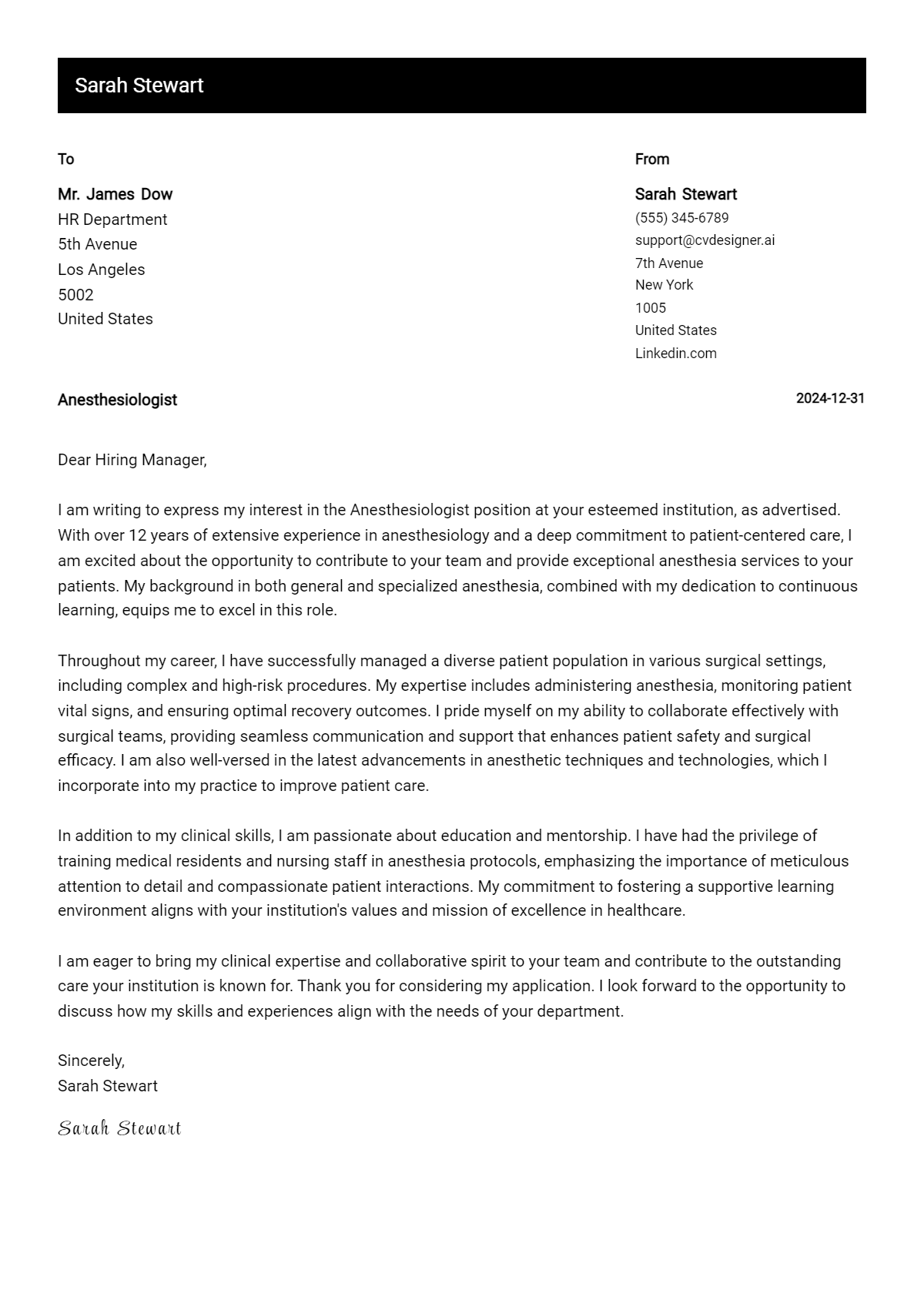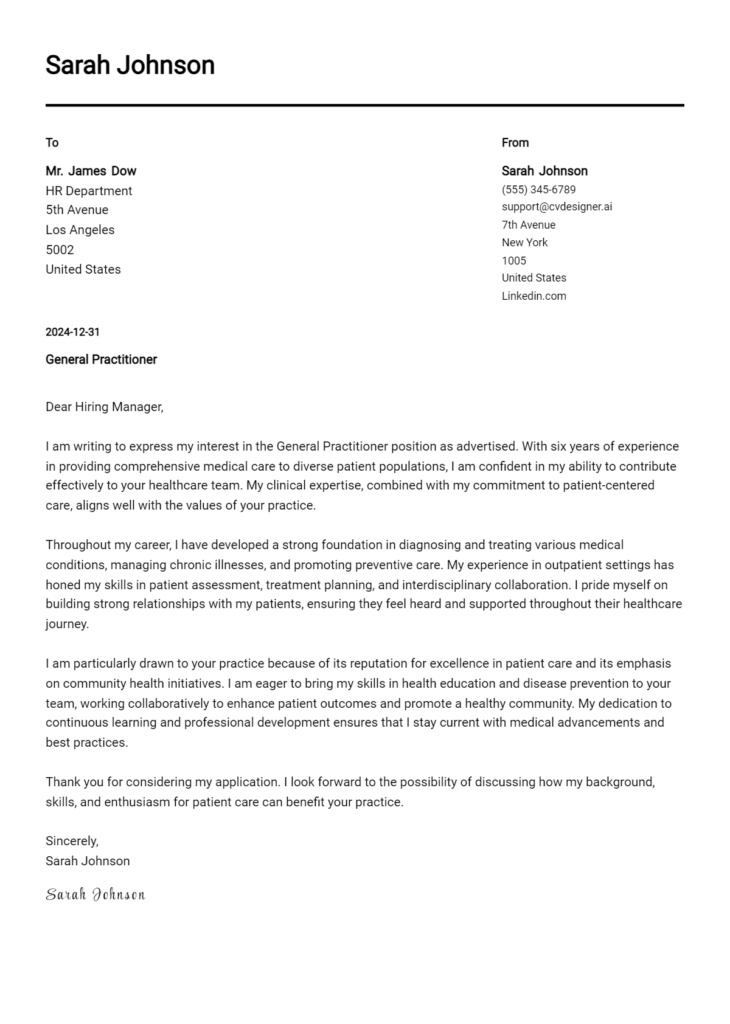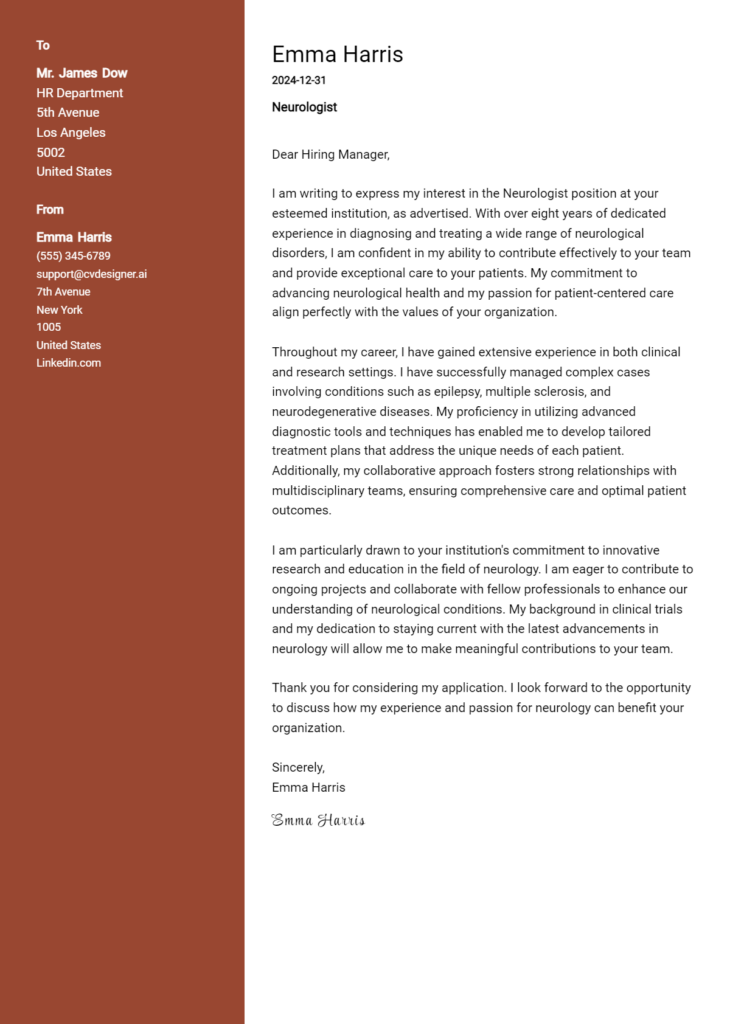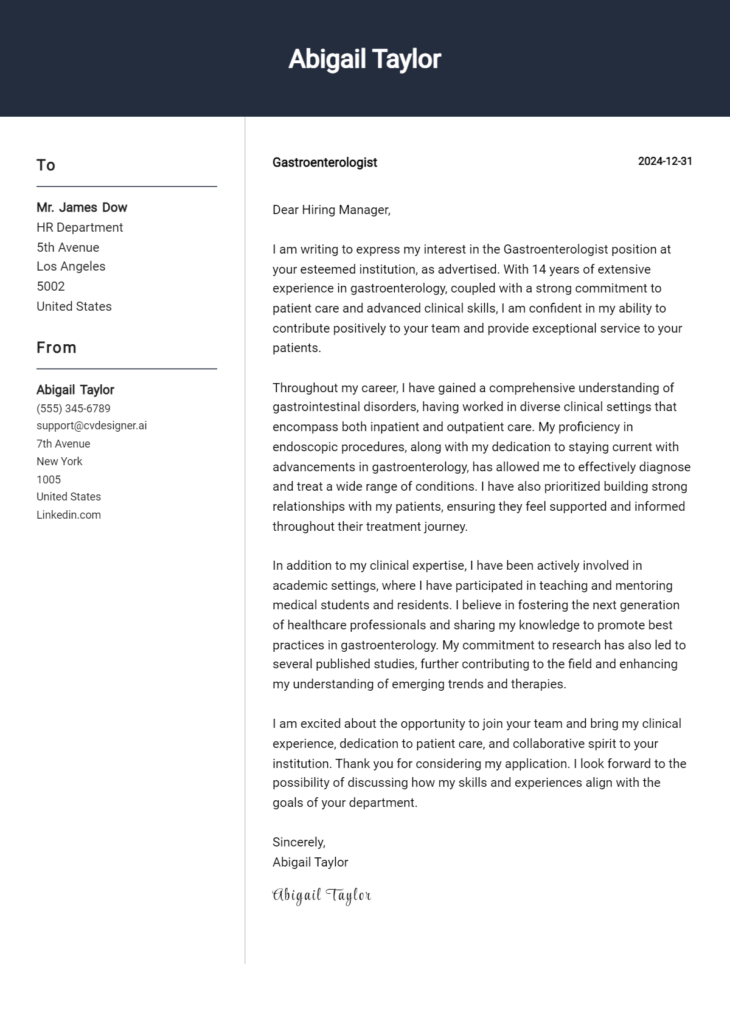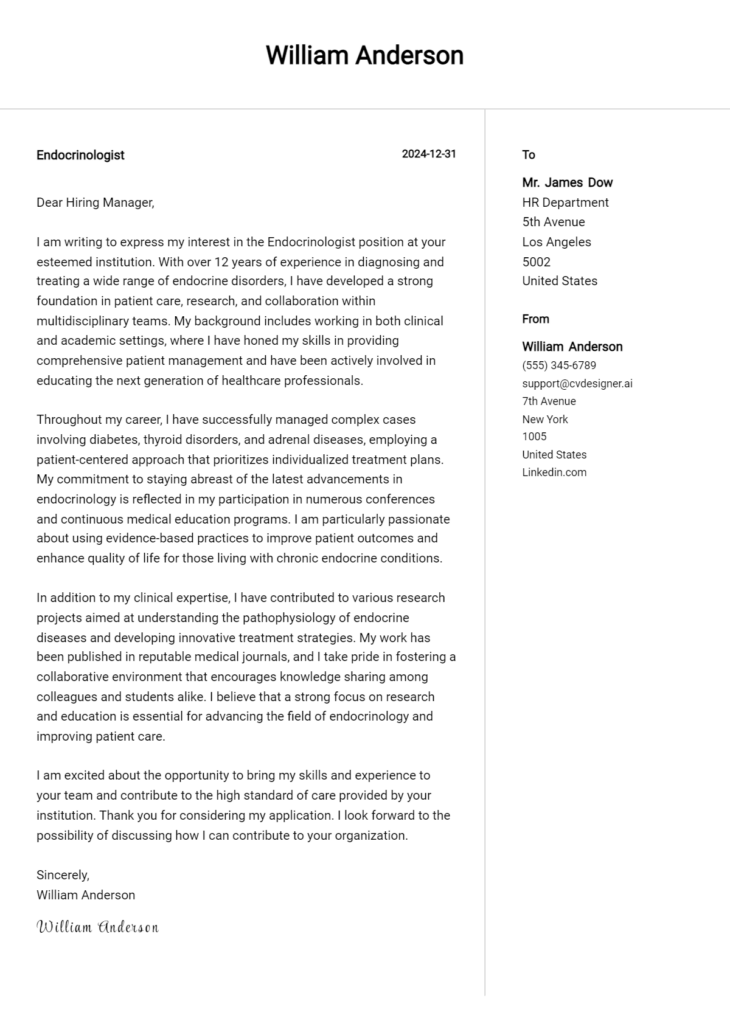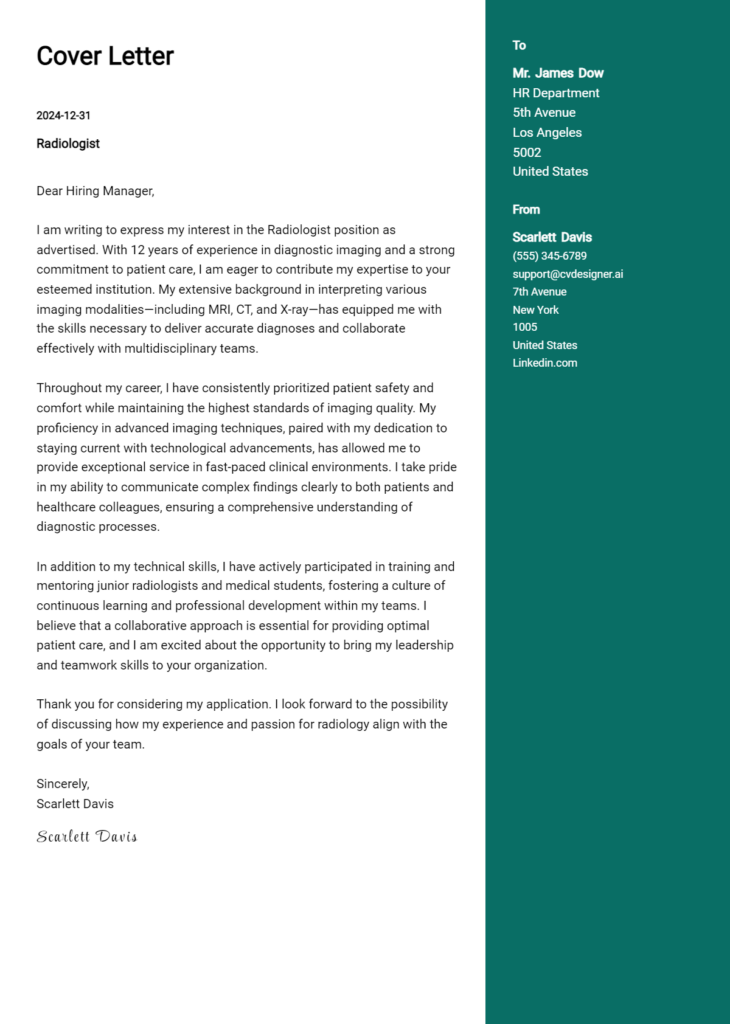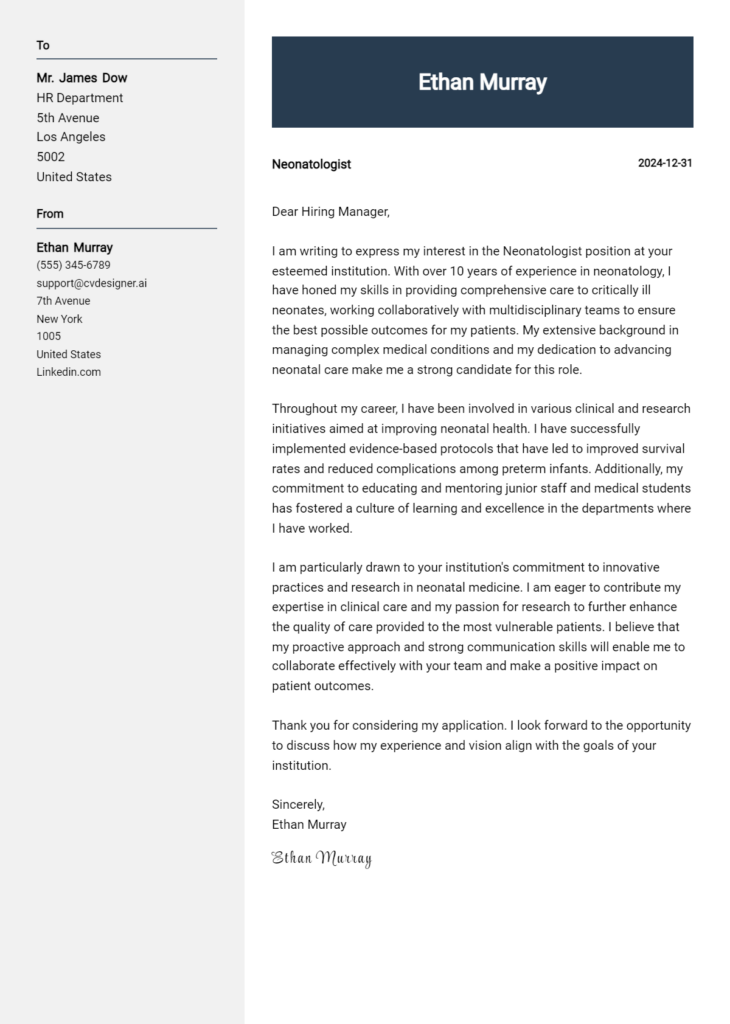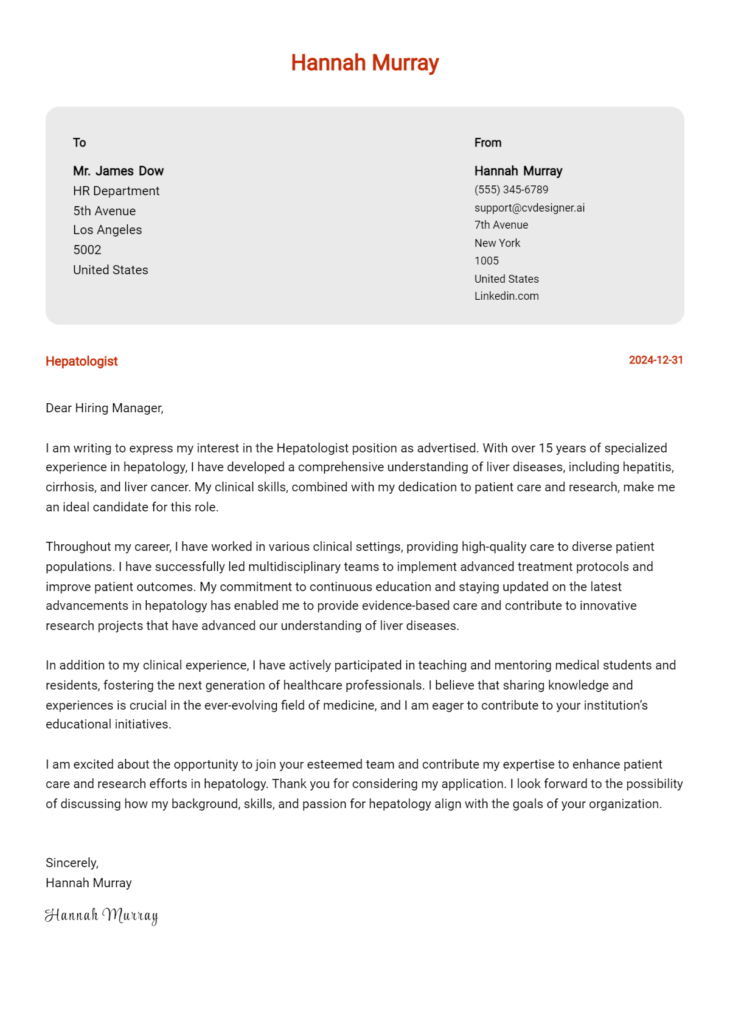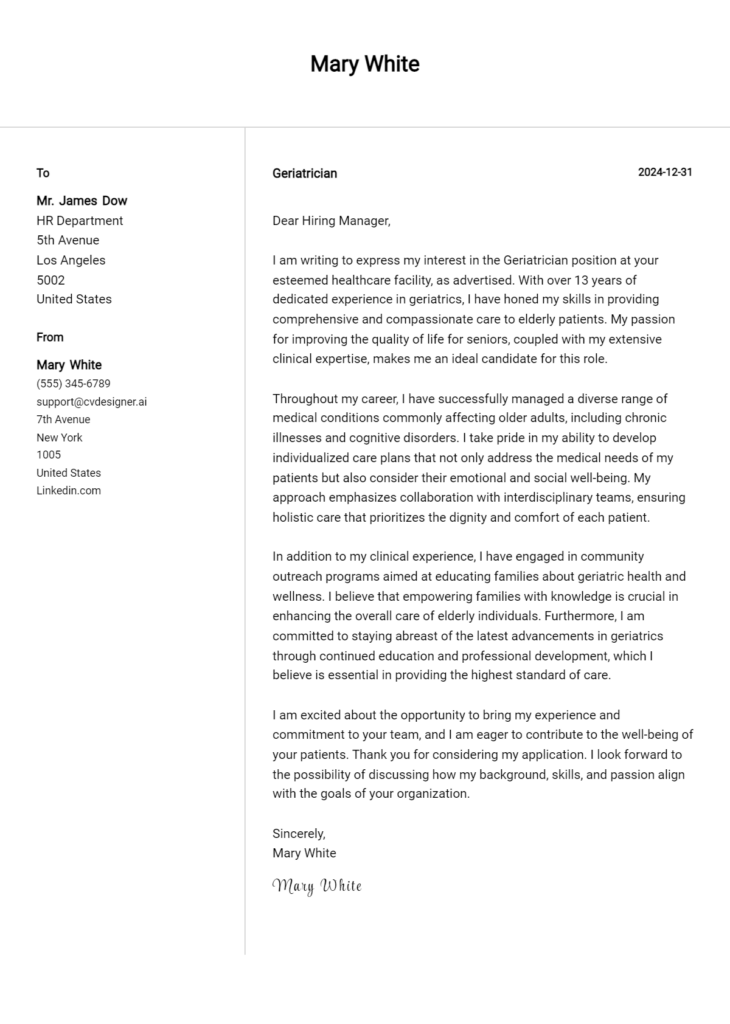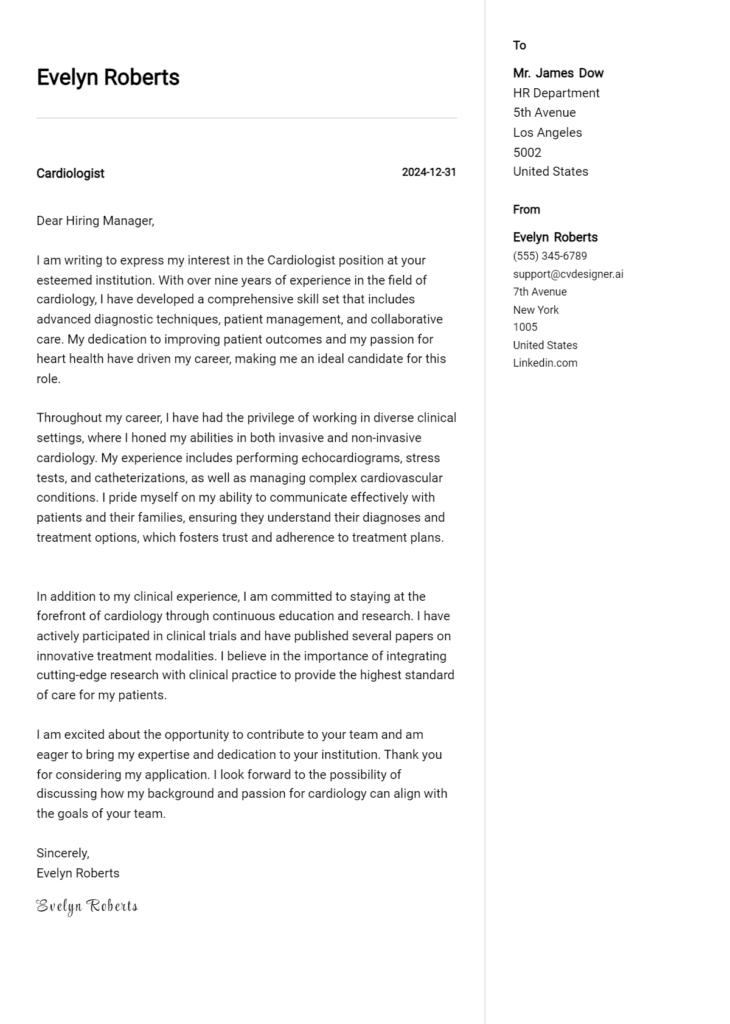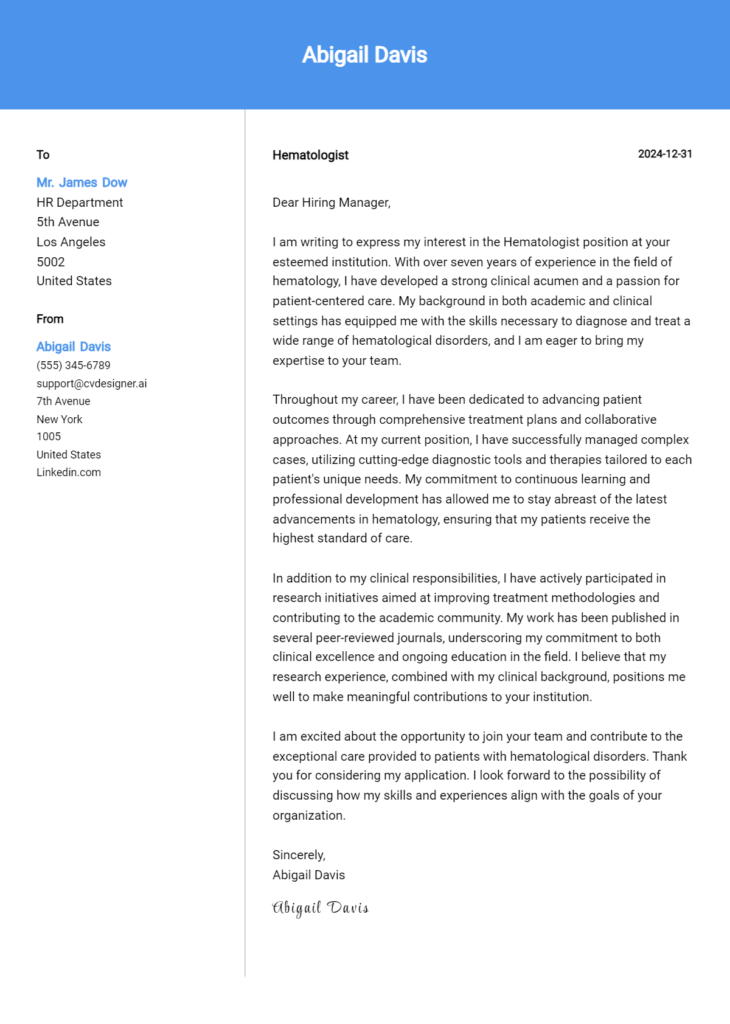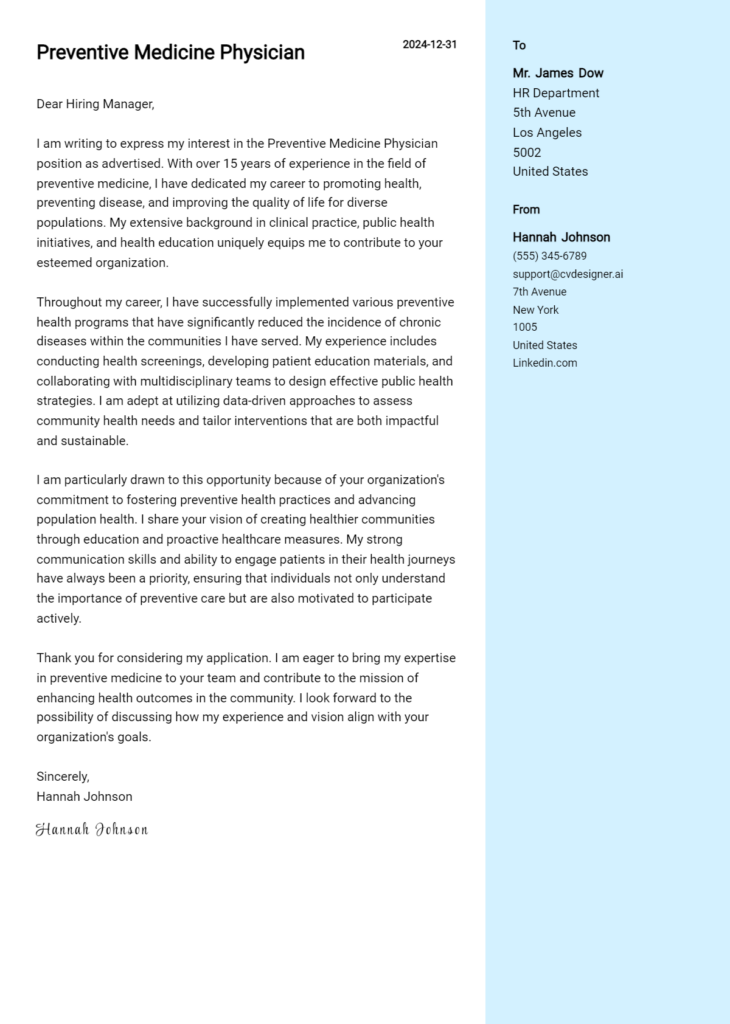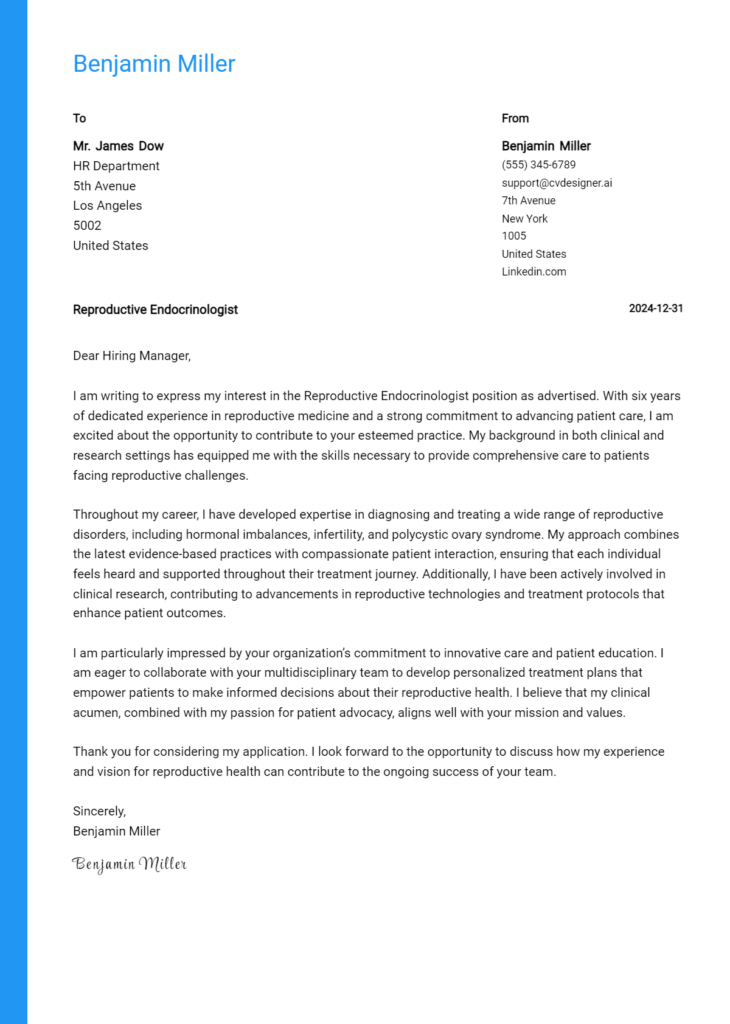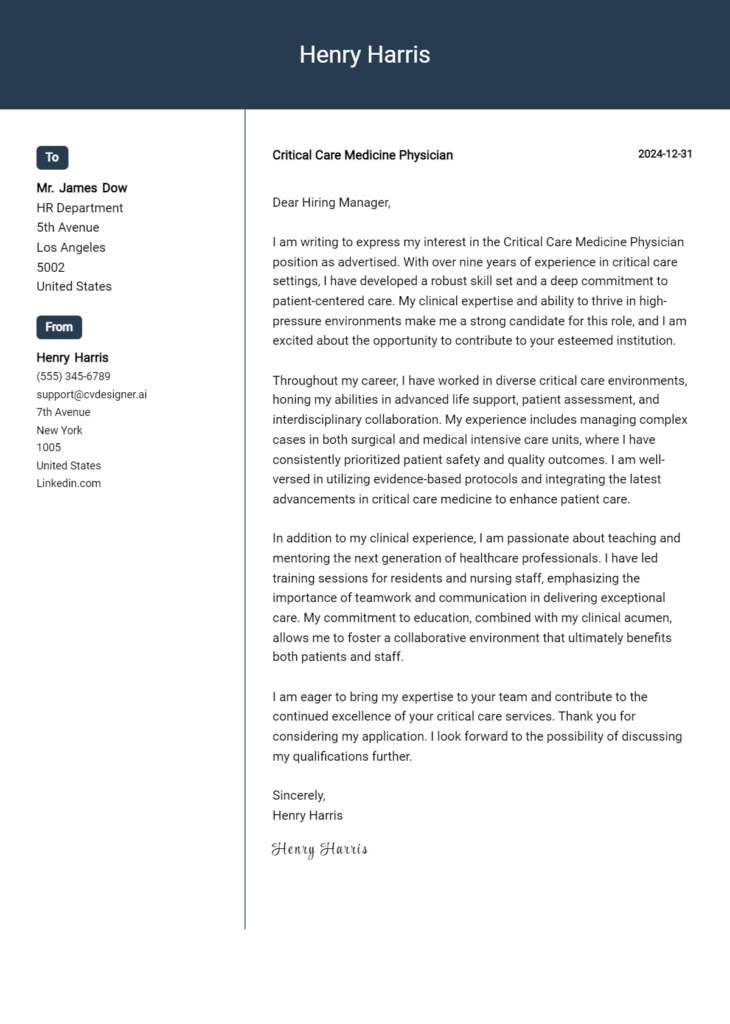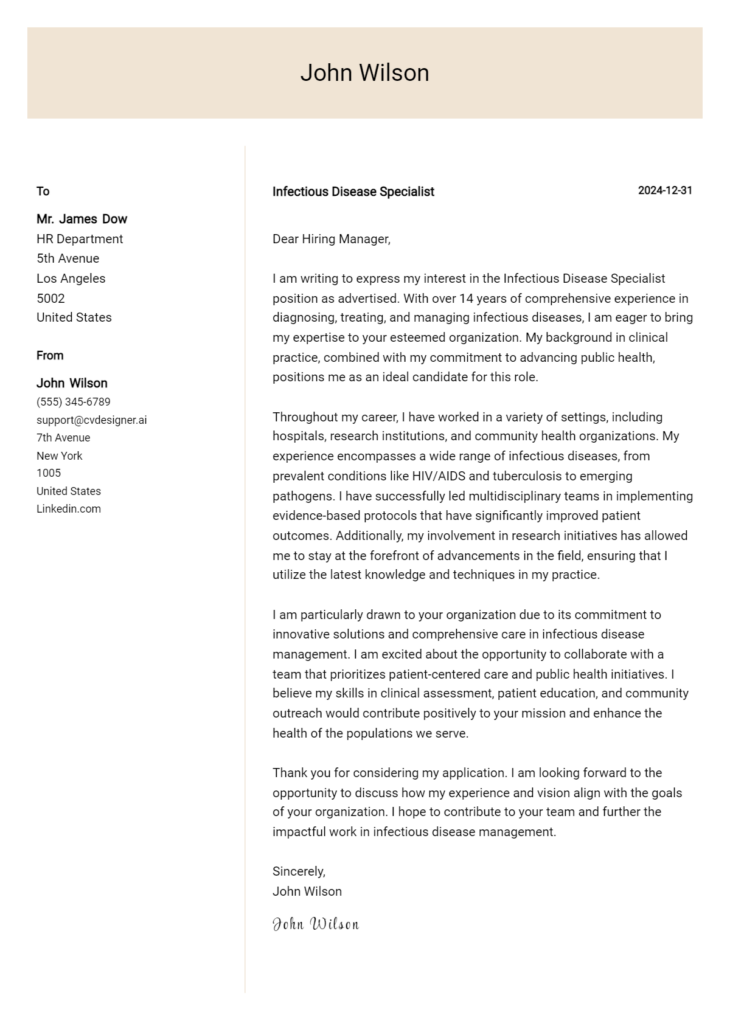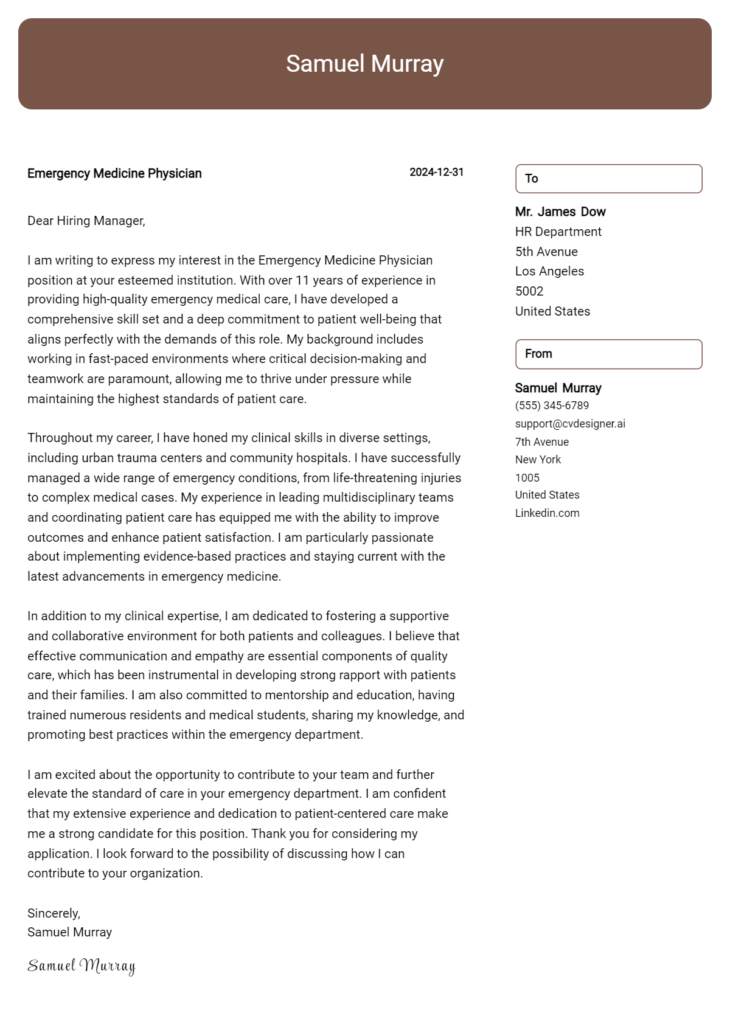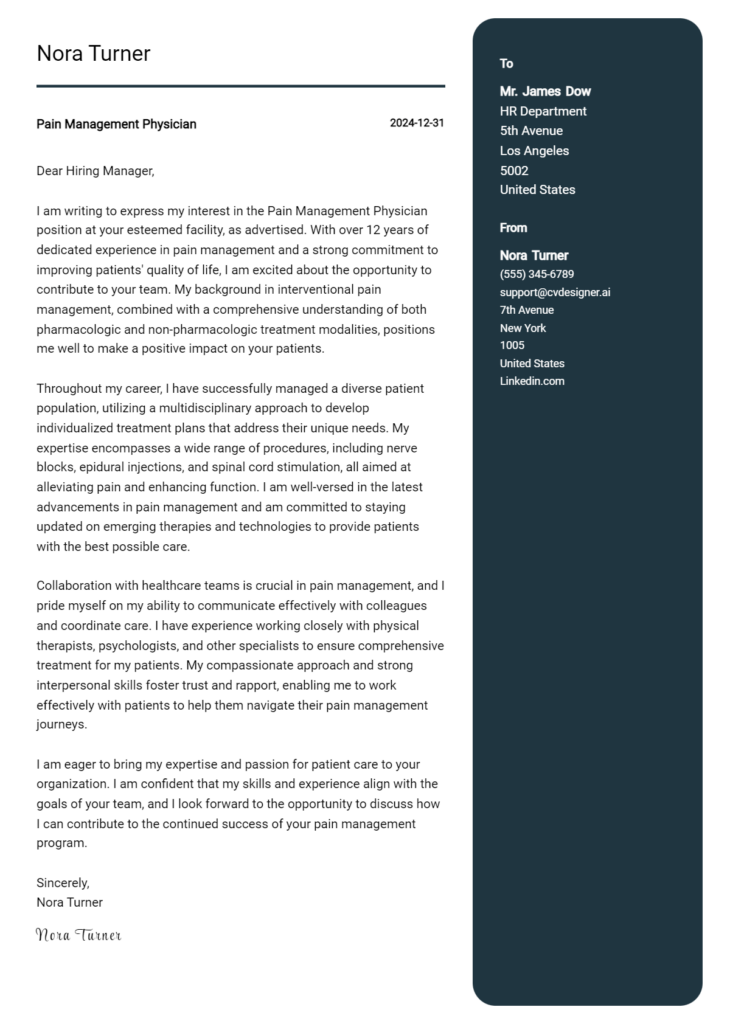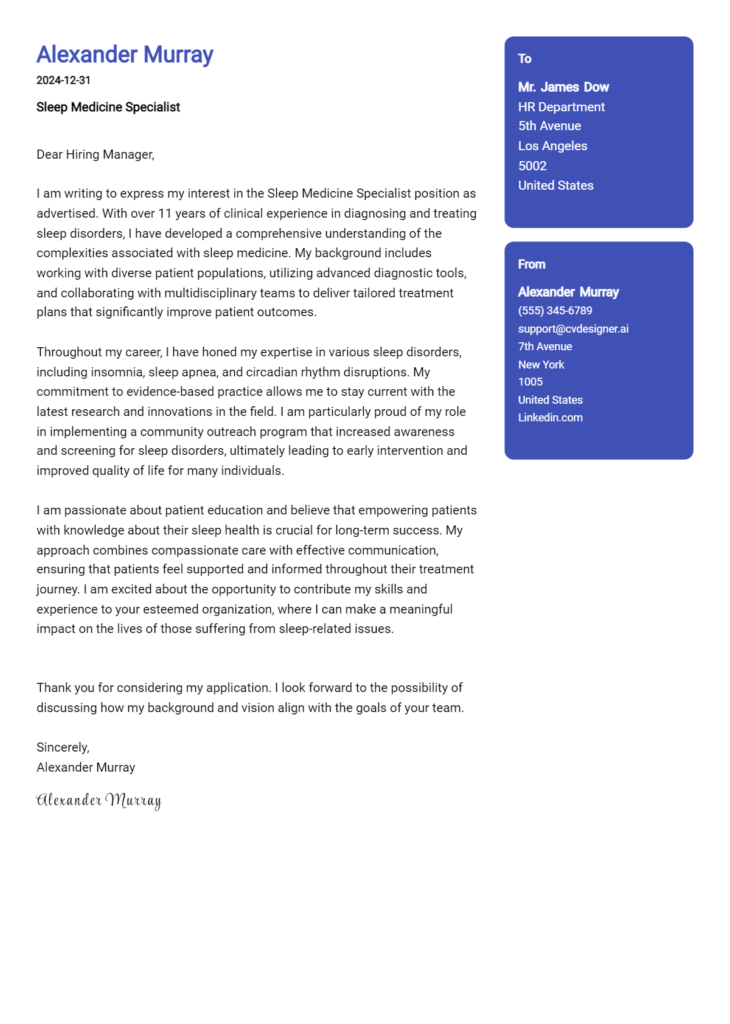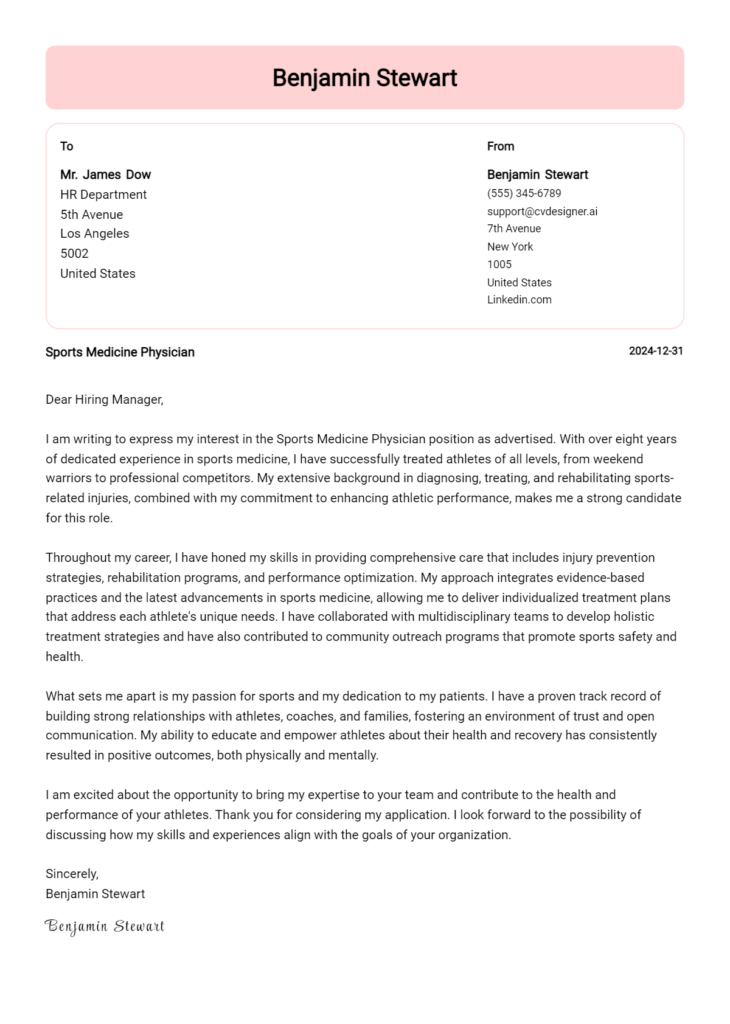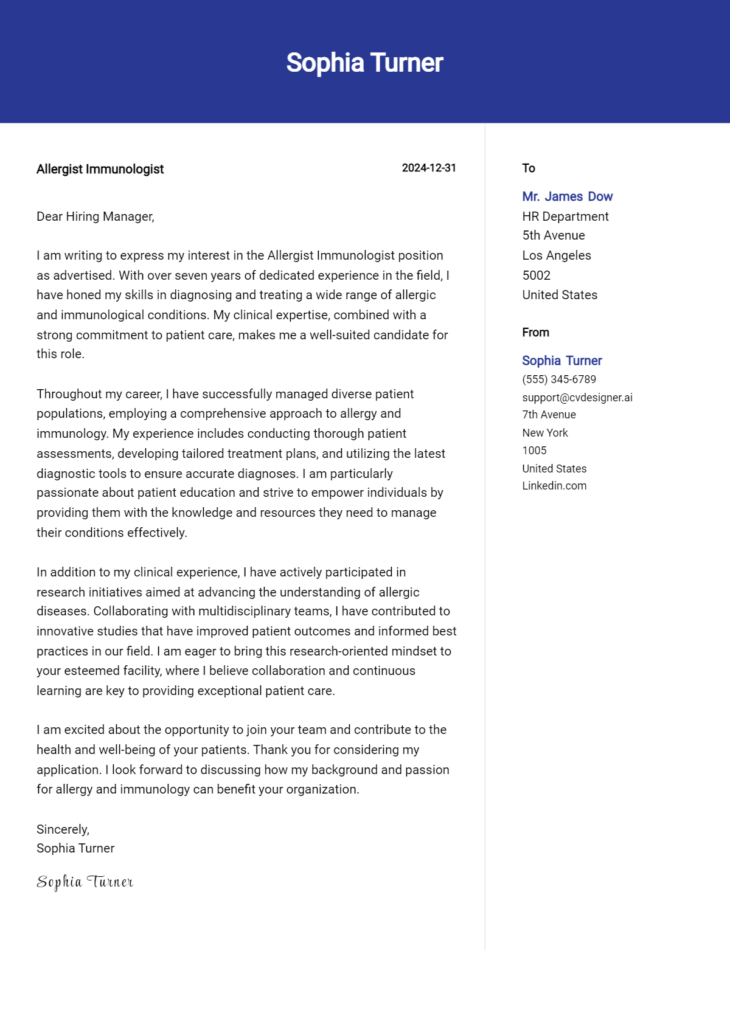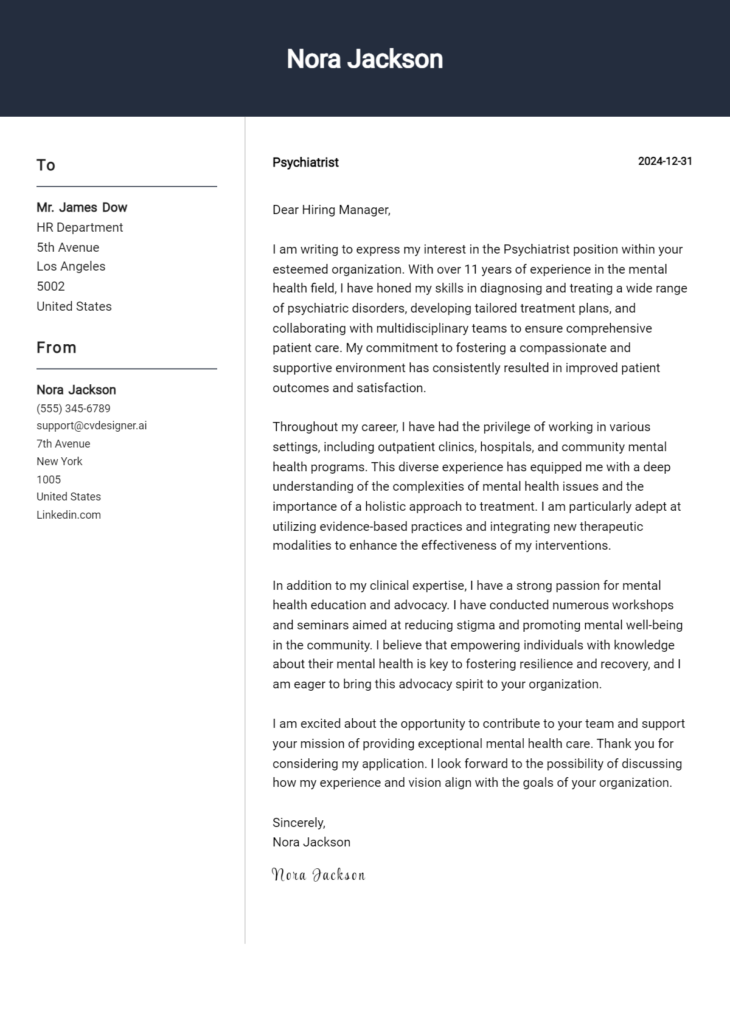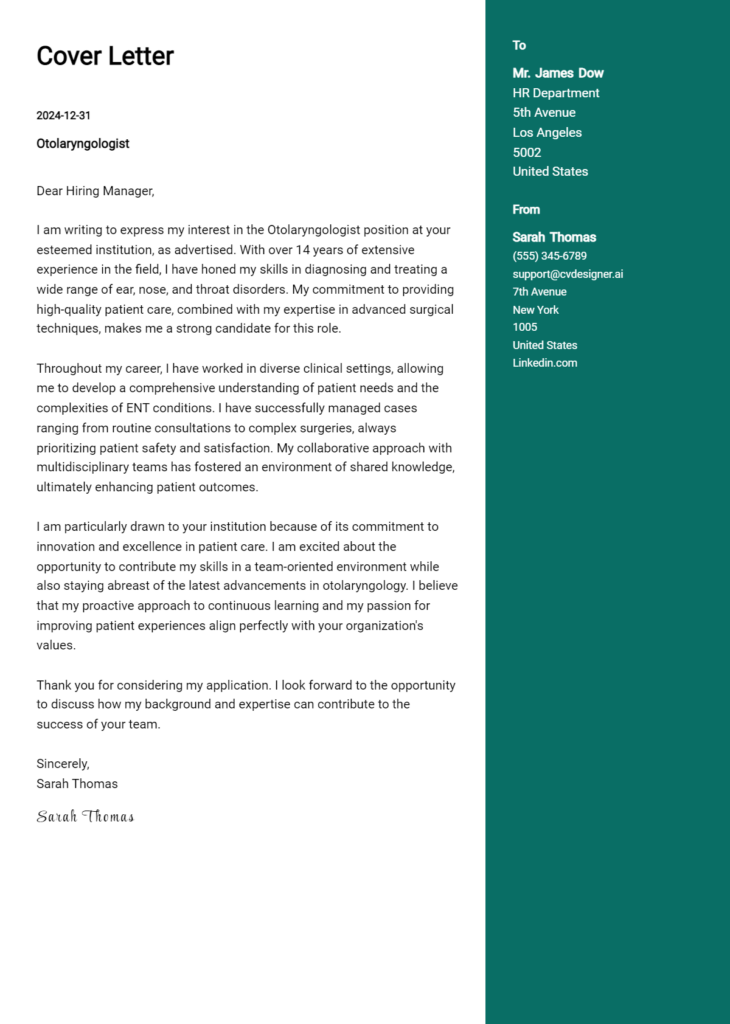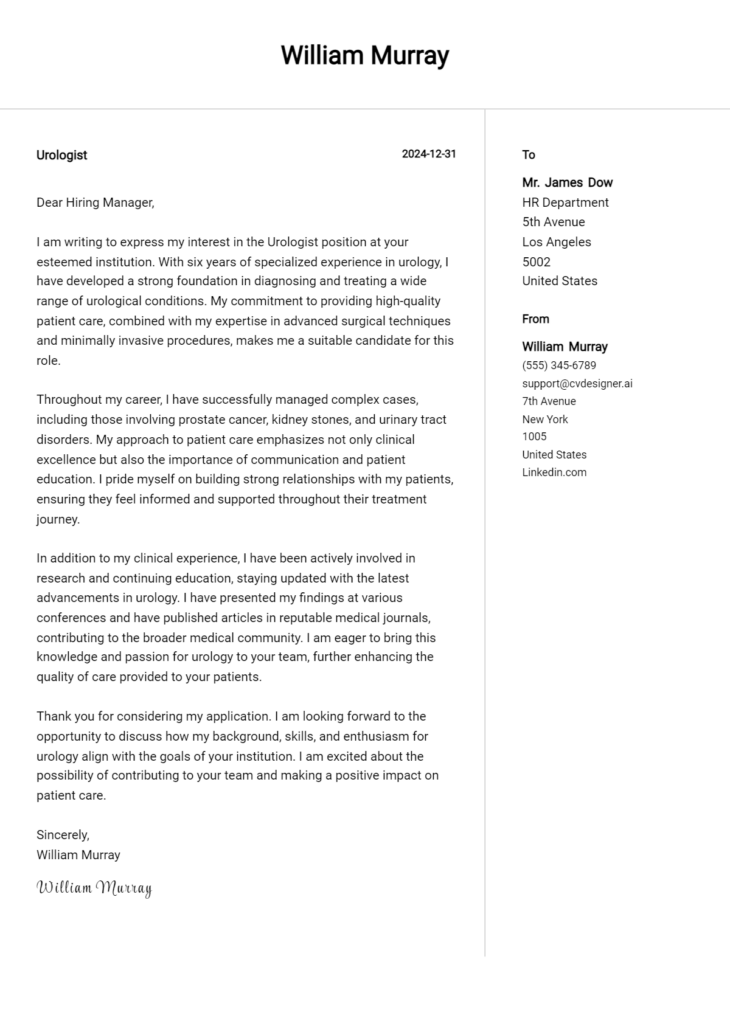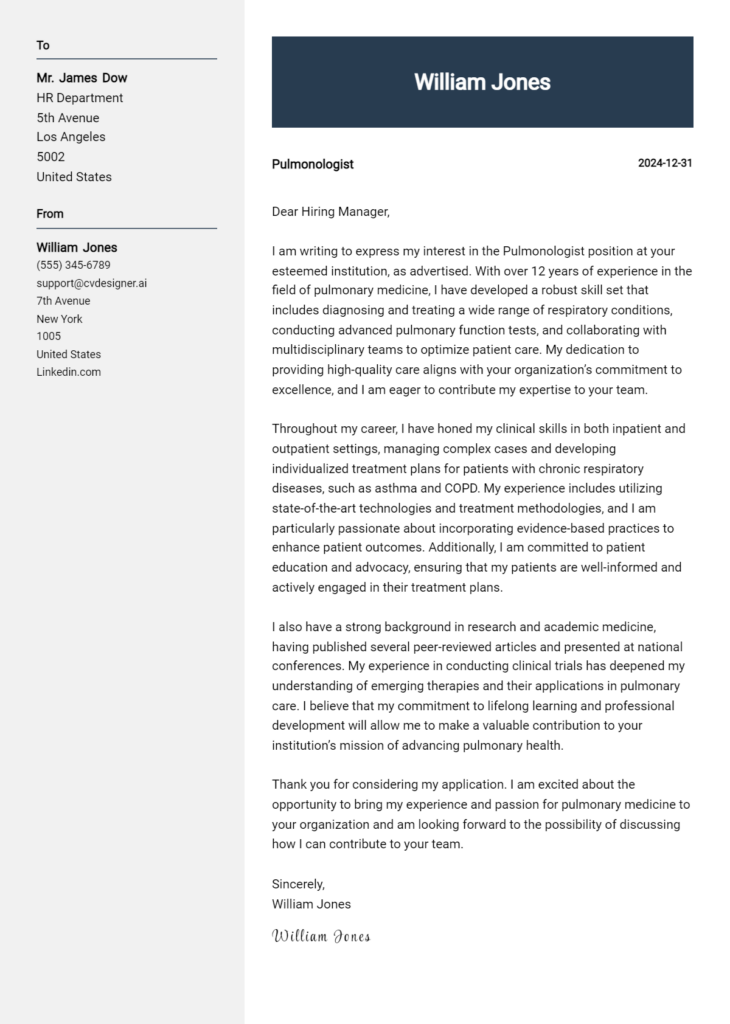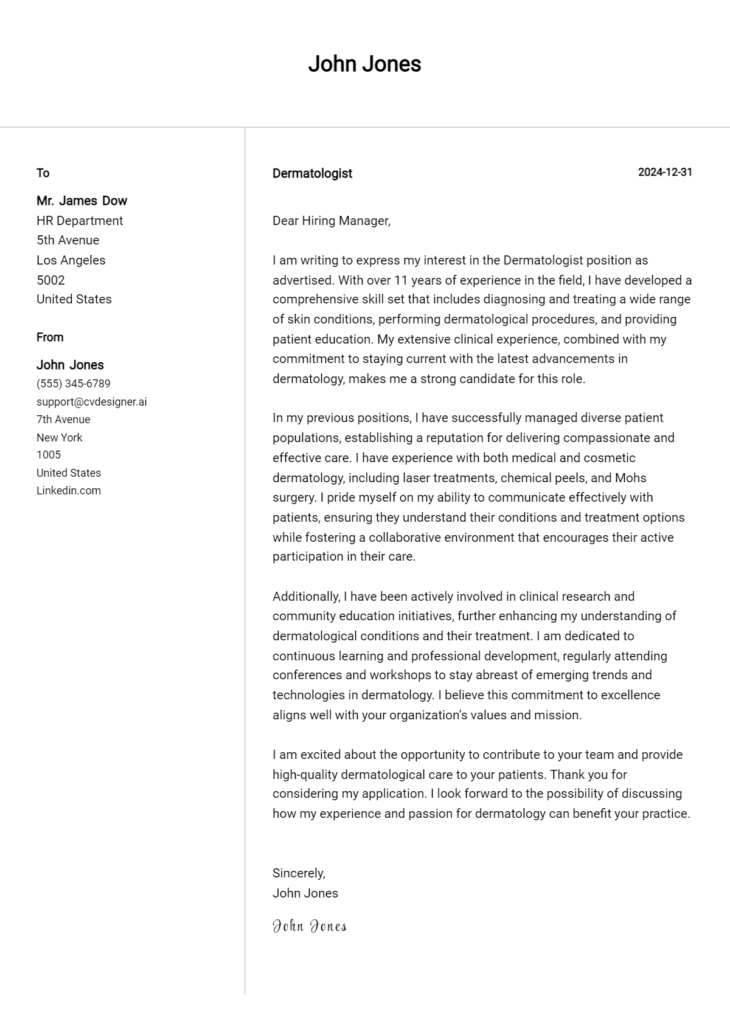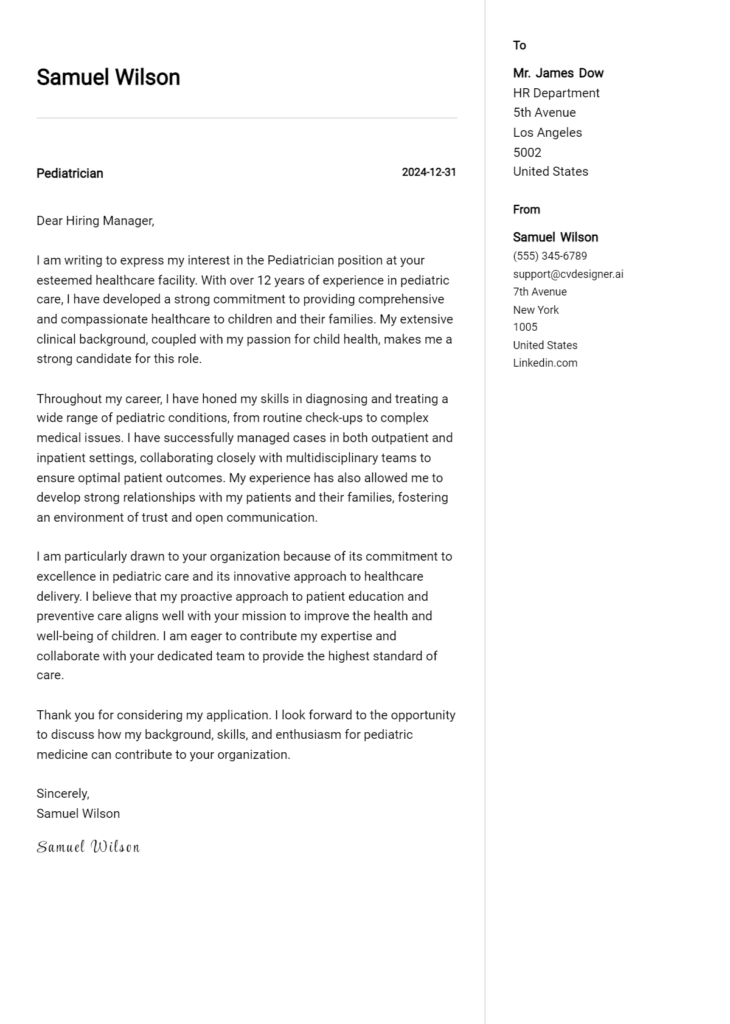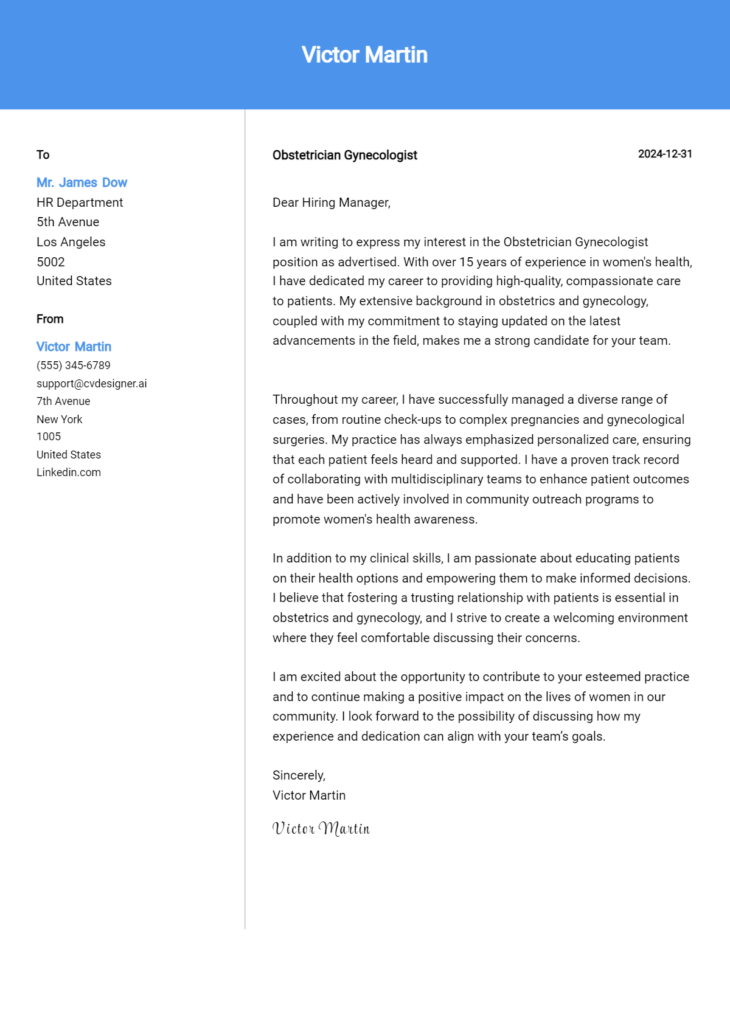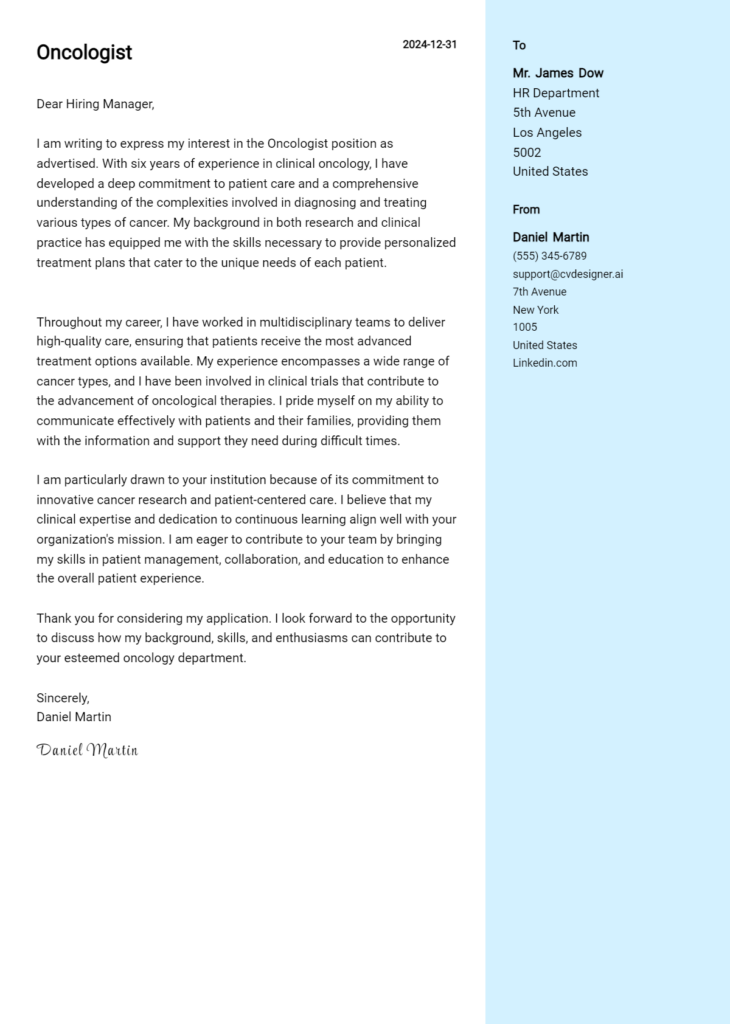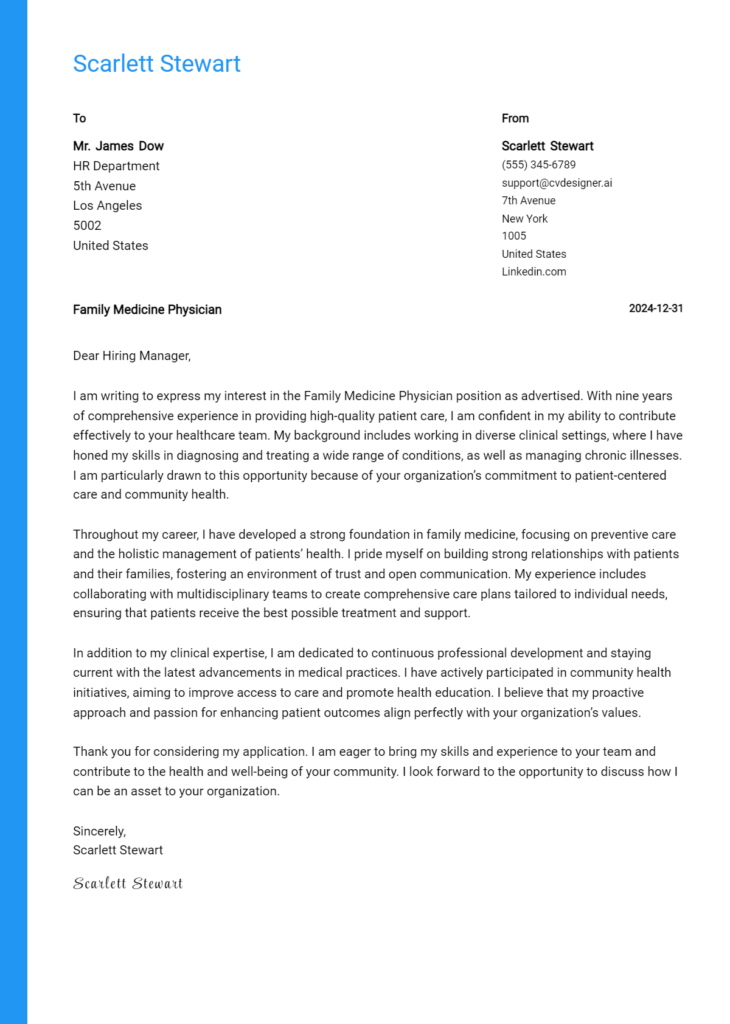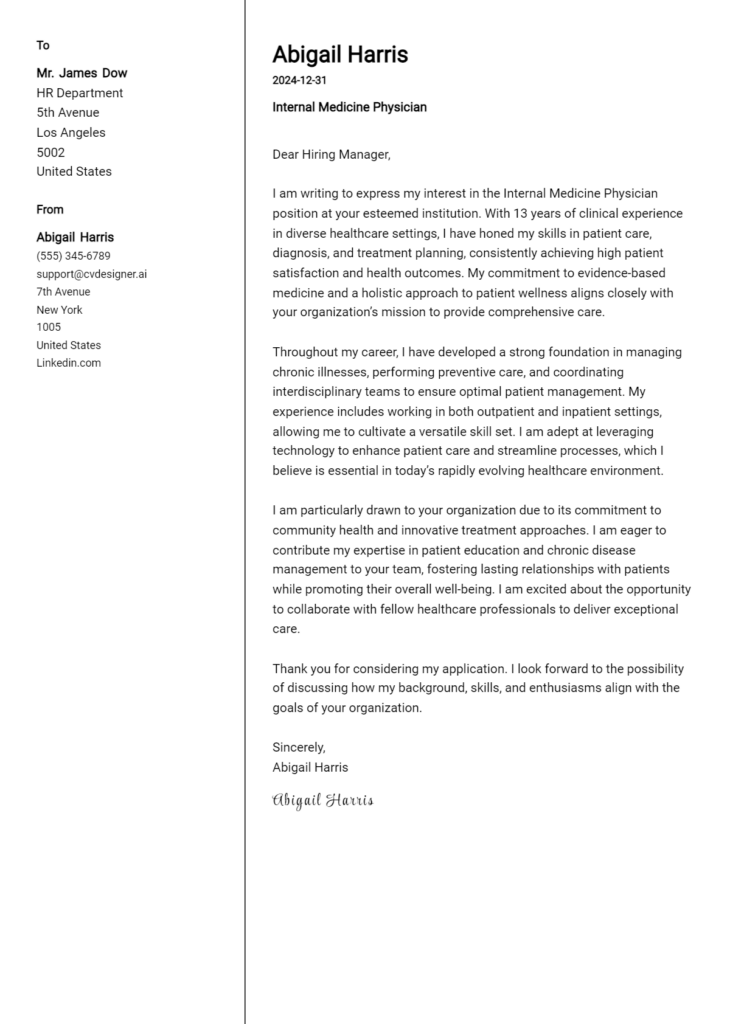Anesthesiologist Cover Letter Examples
Explore additional Anesthesiologist cover letter samples and guides and see what works for your level of experience or role.
How to Format an Anesthesiologist Cover Letter
Crafting a well-structured cover letter is essential for anesthesiologists, as it serves as your first opportunity to make a strong impression on potential employers. The way you present your skills and experiences not only showcases your medical expertise but also reflects your attention to detail and ability to communicate effectively—crucial traits in the high-stakes field of anesthesia. A well-formatted cover letter can help you stand out in a competitive job market by capturing the hiring manager's attention and demonstrating your professionalism.
In this guide, we'll explore how to format your anesthesiologist cover letter, focusing on the key components that will make your application compelling and effective:
- Cover Letter Header
- Cover Letter Greeting
- Cover Letter Introduction
- Cover Letter Body
- Cover Letter Closing
Each section is vital for highlighting your qualifications and establishing a connection with the employer. Let’s delve into each part to help you create an outstanding anesthesiologist cover letter.
Importance of the Cover Letter Header for Anesthesiologist
A well-structured cover letter header is crucial for an Anesthesiologist as it sets the tone for the entire application. It provides essential information at a glance, ensuring clarity and professionalism. The header should include your contact information, the date, and the recipient's details, allowing the hiring manager to easily identify and reach out to you. A strong header not only reflects your attention to detail but also establishes your credibility as a medical professional.
Strong Example
Dr. Jane Doe, MD 123 Main Street Cityville, ST 12345 (123) 456-7890 jane.doe@email.com [Date] Hiring Manager ABC Hospital 456 Health Lane Cityville, ST 12345
Weak Example
Jane Doe 123 Main St jane@email.com Hi there!
The Importance of a Cover Letter Greeting for Anesthesiologists
The greeting of your cover letter is a crucial element that sets the tone for the entire document. A well-crafted greeting not only demonstrates your professionalism but also personalizes your introduction by addressing the hiring manager directly. This small detail can create a positive first impression and show that you have taken the time to research and tailor your application to the specific role and organization. Avoiding generic greetings like "To Whom It May Concern" can enhance your credibility as a candidate. If necessary, take the time to find out the name of the hiring manager or department head to make your greeting more engaging and relevant.
Strong Greeting Example
Dear Dr. Jane Smith,
Weak Greeting Example
To Whom It May Concern,
Cover Letter Introduction for Anesthesiologist
A well-crafted cover letter introduction is crucial for an Anesthesiologist, as it sets the tone for the entire application and serves as the first impression to the hiring manager. This initial paragraph must capture attention, convey genuine enthusiasm for the role, and succinctly highlight relevant skills or achievements that distinguish the candidate from others. A strong introduction not only piques interest but also encourages the reader to continue engaging with the rest of the letter, making it a vital component of a successful job application.
Strong Example
Dear [Hiring Manager's Name], I am excited to apply for the Anesthesiologist position at [Hospital/Clinic Name]. With over eight years of experience in delivering high-quality anesthesia care and a commitment to patient safety, I have successfully managed complex surgical cases while maintaining a calm and supportive environment for patients and their families. My proven track record of collaborating with multidisciplinary teams and my passion for advancing anesthetic practices uniquely position me to contribute positively to your esteemed institution.
Weak Example
To Whom It May Concern, I am writing to apply for the Anesthesiologist position. I have worked as an anesthesiologist for some time and think I would be a good fit. I have done various things in my career, but I’m looking for a new job now.
Purpose of the Cover Letter Body for an Anesthesiologist
The cover letter body for an Anesthesiologist serves as a critical platform to convey the candidate's unique qualifications, experiences, and contributions to the field of anesthesiology. This section should effectively highlight specific projects or accomplishments that showcase the candidate's expertise in pain management, patient care, and collaboration within surgical teams. By detailing relevant experiences, such as successful administration of anesthesia in complex surgeries or implementation of patient safety protocols, the candidate can illustrate their value to the prospective employer. A well-crafted cover letter body not only emphasizes the applicant’s technical skills but also reflects their commitment to providing exceptional care and improving patient outcomes.
Strong Example
Dear Hiring Manager, I am excited to apply for the Anesthesiologist position at [Hospital Name]. With over eight years of experience in diverse surgical settings, I have successfully managed anesthesia care for more than 1,500 procedures, including complex cardiovascular and orthopedic surgeries. My commitment to patient safety is demonstrated through my lead role in a quality improvement project that reduced anesthesia-related complications by 20% over two years. I am also skilled in utilizing advanced monitoring technology to ensure optimal patient outcomes, which aligns with [Hospital Name]'s dedication to high-quality care. I believe that my extensive experience and focus on continuous improvement will make me a valuable asset to your team. Sincerely, [Your Name]
Weak Example
Dear [Hiring Manager's Name], I am writing to express my interest in the Anesthesiologist position at your hospital. I have been working as an anesthesiologist for a few years and have done many procedures. I think I would be a good fit for your team. I am familiar with anesthesia and have worked with various patients. I am looking forward to hearing from you. Best regards, [Your Name]
Importance of the Cover Letter Closing for an Anesthesiologist
The closing paragraph of a cover letter for an anesthesiologist is crucial as it serves to summarize your qualifications, reiterate your enthusiasm for the position, and encourage the hiring manager to take the next step, such as reviewing your resume or scheduling an interview. A strong closing can leave a lasting impression, showcasing your professionalism and genuine interest in contributing to the medical team. In contrast, a weak closing may fail to engage the reader and diminish the overall impact of your application.
Strong Example
In conclusion, my extensive experience in anesthesia administration, along with my commitment to patient safety and comfort, makes me an ideal candidate for the anesthesiologist position at your esteemed facility. I am excited about the opportunity to bring my skills to your team and contribute to exceptional patient care. I look forward to discussing how my background and passion align with the goals of your department. Thank you for considering my application; I hope to speak with you soon about the possibility of an interview.
Weak Example
Thank you for reading my cover letter. I hope you look at my resume. I guess I would like to work for you if you think I’m good enough. Please let me know if you want to talk more.
These tips will help candidates craft an effective cover letter for an Anesthesiologist position. A well-written cover letter is crucial in demonstrating not only your technical skills and expertise but also your problem-solving abilities, familiarity with the software development life cycle (SDLC), and the ability to work as part of a team. Furthermore, showcasing your passion for continuous learning can set you apart from other candidates. Below are five detailed tips to enhance your cover letter.
Cover Letter Writing Tips for Anesthesiologists
Highlight Technical Proficiencies: Clearly articulate your expertise in anesthesia techniques, monitoring equipment, and patient safety protocols. Mention specific anesthetic agents you are proficient with and any advanced techniques you are trained in, such as regional anesthesia or sedation. This is your chance to demonstrate your technical acumen, which is a vital aspect of the role.
Showcase Problem-Solving Skills: Anesthesiologists often face unexpected challenges during procedures. Use examples from your past experiences to illustrate your ability to think critically and solve complex problems under pressure. Describe situations where your quick decision-making improved patient outcomes or resolved issues effectively.
Demonstrate Knowledge of SDLC: While not traditionally associated with the medical field, an understanding of the software development life cycle can be beneficial, especially if you have experience using anesthetic management systems or electronic health records. Mention any relevant software or tools you are familiar with and how they contribute to improving patient care and operational efficiency.
Emphasize Team Collaboration: Anesthesiologists work closely with surgeons, nurses, and other healthcare staff. Highlight your experience in interdisciplinary teamwork and your ability to communicate effectively in high-stakes environments. Provide examples of how your collaboration has led to successful surgical outcomes and enhanced patient safety.
Convey a Commitment to Continuous Learning: The field of anesthesia is ever-evolving, with new techniques and technologies emerging regularly. Express your commitment to professional development through continuing education, attending conferences, or participating in workshops. This demonstrates your dedication to staying current in your field and ensuring the highest standards of patient care.
By incorporating these elements into your cover letter, you can create a compelling narrative that showcases your qualifications and passion for the role. For additional guidance, consider exploring cover letter templates or utilizing a cover letter builder to streamline your writing process.
Common Mistakes to Avoid in an Anesthesiologist Cover Letter
Crafting a compelling cover letter is essential for standing out in the competitive field of anesthesiology. Avoiding common mistakes can significantly enhance your chances of securing an interview. Here are some pitfalls to steer clear of:
Generic Greetings: Using a generic salutation, like "To Whom It May Concern," can make your letter feel impersonal. Always try to address the letter to a specific person, if possible.
Lack of Personalization: Failing to tailor your cover letter to the specific job or institution can be detrimental. Research the facility and mention how your skills align with their values and needs.
Overly Technical Language: While showcasing your expertise is important, using overly technical jargon can alienate the reader. Aim for a balance that conveys your knowledge without overwhelming the hiring manager.
Neglecting Formatting: Poor formatting can distract from your content. Make sure to use a clear cover letter format that includes proper spacing, font size, and alignment to enhance readability.
Repetition of the Resume: Your cover letter should complement your resume, not duplicate it. Focus on key experiences and skills that demonstrate your suitability for the anesthesiologist role without reiterating every detail from your resume.
Ignoring the Closing Paragraph: A weak ending can leave a lasting impression. Clearly express your enthusiasm for the role and include a call to action, inviting the reader to discuss your application further.
Typos and Grammatical Errors: Errors can undermine your professionalism. Always proofread your letter multiple times and consider having someone else review it before submission.
By being mindful of these common mistakes, you can create a more effective cover letter that showcases your qualifications and makes a strong impression. For examples and additional guidance, check out these cover letter examples.
Cover Letter FAQs for Anesthesiologist
What should I include in my anesthesiologist cover letter?
Your cover letter should highlight your qualifications, experience, and passion for anesthesiology. Start with a strong opening that captures the reader's attention. Include your medical degree, residency training, and any fellowships. Emphasize your clinical skills, such as proficiency in various anesthetic techniques and your ability to handle complex cases. Mention any relevant certifications, such as board certification in anesthesiology. Additionally, discuss your teamwork and communication skills, which are crucial in operating room settings. Tailor your cover letter to address the specific needs of the facility you are applying to, demonstrating your understanding of their values and mission.
How can I demonstrate my skills in the cover letter?
To effectively demonstrate your skills in the cover letter, use specific examples from your clinical experience. Highlight scenarios where you successfully managed anesthesia for high-risk surgeries, showcasing your technical expertise and decision-making abilities. Discuss your experience with different patient demographics and surgical procedures, emphasizing your adaptability and patient-centered approach. If you have engaged in quality improvement initiatives or research in anesthesiology, mention those as well. Quantifying your achievements—such as improvements in patient recovery times or satisfaction scores—can add impact. This approach not only illustrates your skills but also shows your commitment to advancing the field.
Should I mention my goals in my cover letter?
Yes, mentioning your professional goals in your cover letter is essential. It provides insight into your career aspirations and helps the hiring committee understand how you align with their institution's mission. Clearly articulate your passion for anesthesiology and any specific areas of interest, such as pain management, pediatric anesthesia, or critical care. Discuss how you envision contributing to the team and enhancing patient care. Additionally, mention how the position aligns with your career development, whether it's through mentorship opportunities, leadership roles, or involvement in research. This connection shows that you are not only looking for a job but are invested in your professional growth within their organization.
How do I tailor my cover letter for a specific anesthesiology position?
Tailoring your cover letter involves researching the specific anesthesiology position and the institution's culture. Start by reviewing the job description thoroughly to identify key responsibilities and required skills. Incorporate relevant keywords and phrases from the job listing to align your qualifications with their needs. Mention any unique aspects of the institution, such as their commitment to patient care, innovative practices, or community involvement, and how those resonate with your values. Additionally, if you know about specific challenges the facility faces, address how your experience could help overcome those issues. This personalized approach demonstrates your genuine interest in the position and makes your application stand out.
Build your Cover Letter in minutes
Use an AI-powered cover letter builder and have your letter done in 5 minutes. Just select your template and our software will guide you through the process.

